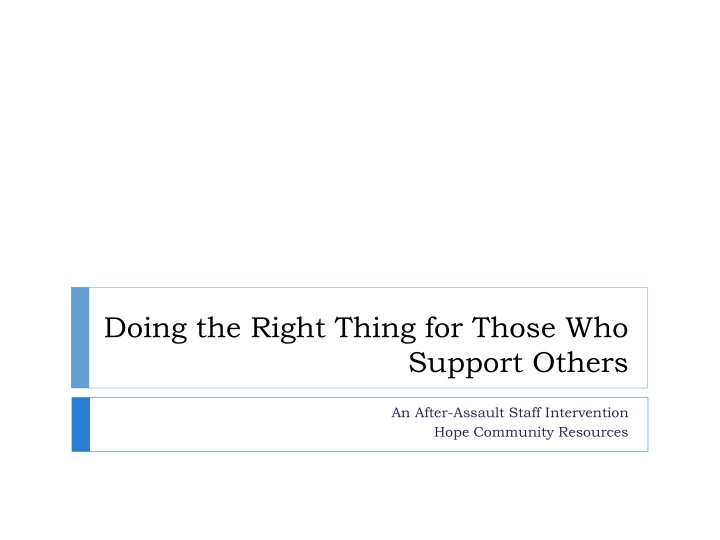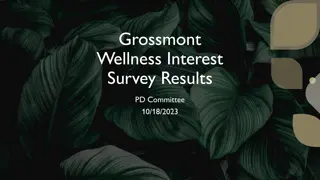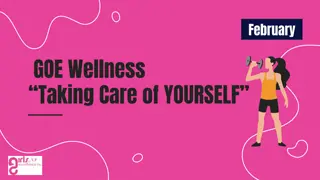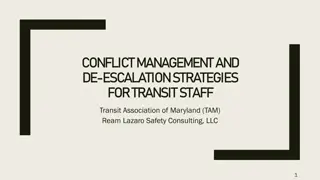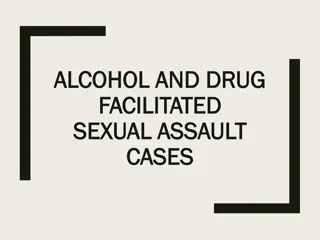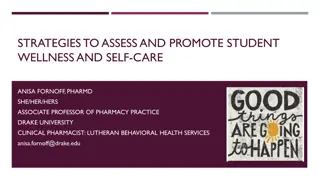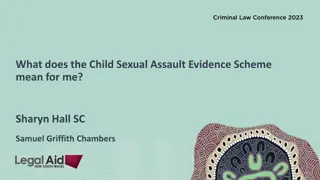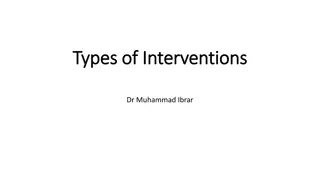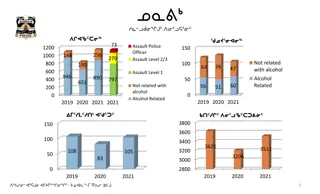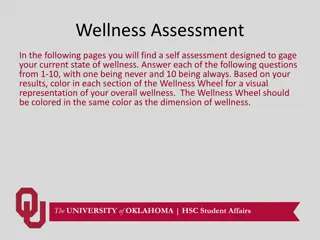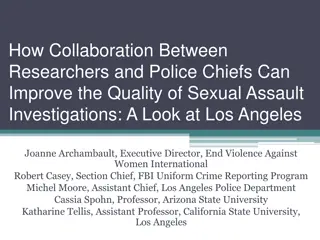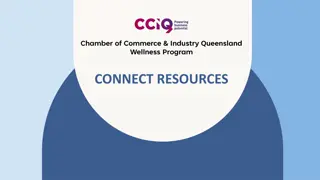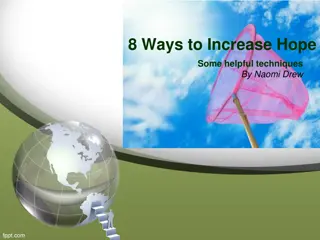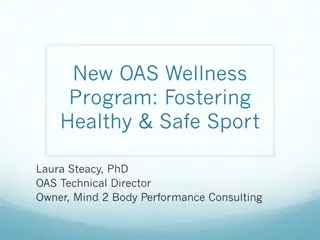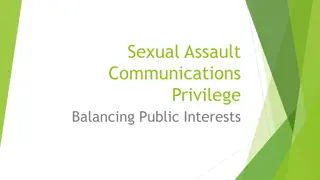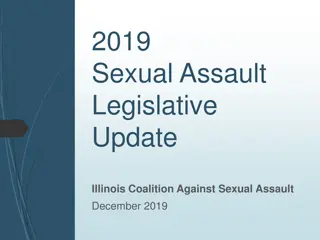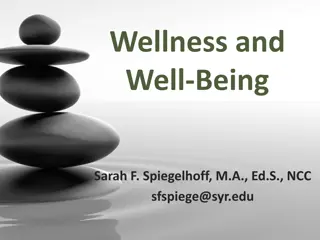Supporting Staff Wellness After Assault: Hope's Intervention Program
Hope has implemented a staff wellness initiative focusing on supporting employees after incidents of aggression. Through research, training, and a consistent protocol based on the Mitchell Model of Critical Incident Stress Management, Hope aims to provide effective intervention and support for staff members. A pilot project design includes notifications of assault incidents and telephone interventions to ensure staff well-being and the ability to continue caring for others.
Download Presentation

Please find below an Image/Link to download the presentation.
The content on the website is provided AS IS for your information and personal use only. It may not be sold, licensed, or shared on other websites without obtaining consent from the author.If you encounter any issues during the download, it is possible that the publisher has removed the file from their server.
You are allowed to download the files provided on this website for personal or commercial use, subject to the condition that they are used lawfully. All files are the property of their respective owners.
The content on the website is provided AS IS for your information and personal use only. It may not be sold, licensed, or shared on other websites without obtaining consent from the author.
E N D
Presentation Transcript
Doing the Right Thing for Those Who Support Others An After-Assault Staff Intervention Hope Community Resources
The Story Hope has led a staff wellness initiative for over 15 years. Wellness Seminars Employee Assistance Program Wellness Staff June 2015 Regular Critical Incident follow-up meeting Do we do anything supportive with a staff person after an incident of aggression? Do we try to ensure that the staff person can still be truly caring and supportive with that person after the incident?
Statistics at Hope From 2005 to 2015 Census 900-1000 765 total altercations/aggression episodes on staff (broad definition of aggression) 70 per year One or two per week
Research Review of literature on workplace violence and trauma intervention Organizations Eight interviews and site visits Other DD agencies Hospitals Mental health hospitals Public schools
Preliminary Conclusions A consistent protocol to support a staff person after an assault is needed. After research and careful consideration, we will apply the Mitchell Model of Critical Incident Stress Management; it is the most-referenced in the (mixed) literature, and it seems to fit Hope s situation and needs best. We need to be trained in this model before we proceed.
Training January 2016 Three-Day Combined Training International Critical Incident Stress Foundation (the Mitchell /CISM model) Alaska Trauma Center Retired Anchorage Police Department chaplain 13 contact hours in Assisting Individuals in Crisis 14 hours in Group Crisis Intervention This training was by far the most relevant and helpful to our situation at Hope.
Pilot Project Design Notification of assault incident by Internal Incident Report Telephone call explaining the intervention The intervention 1. 2. 3.
The Telephone Call Introduction of the interventionist I understand you were harmed by someone you support. I would like to just pause and take a moment to get with you and check to be sure you re okay. Purposes: to touch base, for personal support , to provide a safe place to talk freely The purpose is not to investigate the incident or find fault with the staff person. It will probably only take about 30 minutes. I have some materials I want to give you to help you. Explanation of confidentiality (except anything illegal or dangerous to anyone) Your participation is voluntary but I encourage you to talk for your own benefit. If the staff person refuses the intervention, offer contact information.
The Intervention The Incident A one-on-one conversation A location with some privacy Brief review of the telephone conversation Tell me a little about what happened. What was the worst part about what happened? Discuss physical injuries, medical treatment, and possible workman s compensation claim. If the interventionist suspects the staff person was at fault or may have actually caused the assault, the procedure is to say nothing during the intervention, and then later advise the agency s In-House Counsel to review the Internal Incident Report again.
The Intervention Impacts of the Incident How is this incident affecting you now? Sleep exhaustion, or sleeplessness Memories Feelings of anger Feelings of fear Numb Reminding you of other experiences in your life Using drugs or alcohol Affects in your family or other relationships Your feelings and responses are all normal responses to an abnormal situation.
The Intervention - Two Hand-Outs Doing the Right Thing for Yourself Doing the Right Thing for the Person You Support 1. 2.
1. Doing the Right Thing for Yourself A list of strategies for self-care and stress relief after a traumatic incident, adapted with permission from the ICISF Self-Care and Stress Management Do s and Don ts, adapted with permission from Providence Alaska Medical Center Applying these strategies soon may reduce post-traumatic stress symptoms almost completely.
2. Doing the Right Thing for the Person You Support Thank you for your work at Hope. We know you were drawn to this work for many personal reasons mainly because you care. Based on your caring heart, please do some soul-searching about what happened. Take some quiet time and honestly reflect on these questions:
2. Doing the Right Thing for the Person You Support How much has your relationship with the support recipient been affected by what happened? Can you go back to work prepared to care in a way that will continue good services for that person? Do you think it would be better for another staff person to work with that person? Explanation how a transfer within the agency works
The Intervention Wrap-up Ask Do you have any questions for me? (Ask yourself Are we done here? ) Contact information for the Employee Assistance Program Contact information for the interventionist Follow-up phone call from Human Resources about a week later
Two Follow-up Questions from HR On a 1-to-10 scale, how helpful were these conversations to you (with 1 being not helpful at all and 10 being most helpful)? On a 1-to-10 scale, how glad are you that we reached out to you (with 1 being not glad at all and 10 being very glad)?
Pilot Project Approved by Executive Leadership Data points Total number of interventions How soon after assault incident? Staff refusals of the intervention Time spent on each intervention Transfer requests Any unhealthy coping mechanisms? Impacts on the interventionist Answers to follow-up questions Parameters July-October 2016 Three months (100 days) Only in the Anchorage region Only incidents of physical assault hits, kicks, slaps, bites Only one interventionist
Pilot Project Results Total Internal Incident Reports scanned 377 26 per week average Total interventions 22 6% of total Internal Incident Reports One or two interventions per week 16 women, 6 men Refusals Only one staff person did not return the phone call.
Pilot Project Results Intervention locations Group homes 12 Main administrative building 3 Mental Health waiting room Public park Family home Agency art studio
Pilot Project Results Telephone contact how soon after incident almost always the same day the Internal Incident Report was posted Intervention how soon after incident From 12 hours up to seven days Two days average How much time spent per intervention From 30 minutes up to three hours One hour average
Pilot Project Results Transfer requests after intervention There were no transfer requests specifically based on the incident and intervention. Two people did leave the agency since the incidents (for other reasons?). Coping responses/denials There were some ( it comes with the territory ). Staff were very open to reviewing incidents, to learn how to do it better next time. Staff consistently showed good self-care, a professional perspective on the incident, and sincere concern for the person who assaulted them.
Pilot Project Results Impacts on interventionist After scanning many Internal Incident Reports and doing several interventions in one week, woke up from a dream of being assaulted in a group home. Reviewed and applied strategies from Doing the Right Thing for Yourself. How glad are you that we reached out to you? 9.3 out of 10 How helpful were these conversations to you? 9.2 out of 10
Staff Comments During Pilot Project Thank you for the follow-up. I think it s wonderful that you are doing this. makes you feel that someone cares if I were really struggling, it would be really nice to know that I have people that care and are here to support me. having the handouts to really look over, read and think about what was saying really made me think about some things. I really appreciated that. It is really comforting to know that you are out there. I can see how it would be helpful for others who might need it. I really have been just doing this for so long that I know what to expect. I think it is such a wonderful thing to know that your agency has your back. This is going to be an amazing thing for current and future employees.
Protocol The After-Assault Staff Intervention was approved as an official protocol of Hope Community Resources. The protocol is now expanded to all the other regions of Alaska, by means of telephone interventions. The definition of assault remains the same physical assaults only. We will continue to capture data on interventions for one year. In the future we will train more interventionists to form an intervention team. We are happy to share what we are learning at Hope!
Doing the Right Thing for Those Who Support Others rbenjamin@hopealaska.org (907)433-4707
